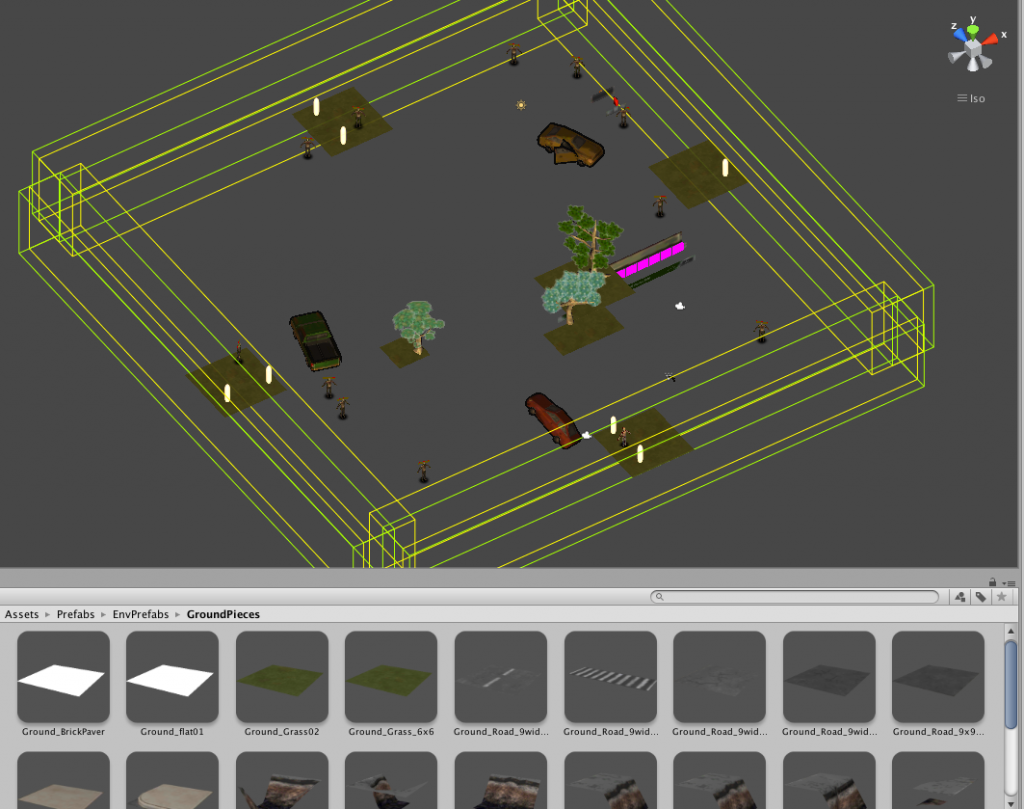Creating a full 3D game can be a daunting task for a small team of indie developers. Getting that 3D to work on mobile devices only adds to the challenge. In a recent issue of the IGDA Insider newsletter, I describe some of the challenges facing indie developers who want to make 3D games and how indies can decide whether 3D is right for them.
Among this advice, I took some time to discuss my team's current work with Dead Man's Trail, specifically our methods for level construction and character art.
For DMT, the Pie For Breakfast and e4 Software teams are utilizing tile-based level construction methods.
Pre-made level tiles are useful for engines such as Unity and others which come with no pre-made level construction toolsets. In many ways, they work like building with Lego bricks. Designers create the pieces they need then can construct the levels they want from combination of these pieces.
Levels consist of several "tiles", which designers build by first placing the desired exits, then filling in with the pathways that players can use to get from one place to another. Designing with a goal in mind helps the designer fill in the fun moments of gameplay that they would like players to experience as they move through the level.
In the IGDA article, I had this to say about making these kinds of levels work in the actual game and how such a workflow fits into a tightly-scheduled team experience:
Chris wrote: An artist should be able to produce a complete color mapped 3D character model in 12 to 18 hours of work. Likewise, they should be able to produce environment assets both quickly and in such a way that they are modular – able to be used in multiple places in the environment. A building, for example, may be broken into several types of pieces – plain walls, window, doors, cornices, ornaments, roofs, etc. – that are assembled by a level designer in-engine. These pieces are often converted into one efficient mesh by a mesh packing script so that the frame rate doesn’t slow down with too many individual objects in a scene – something that an artist can coordinate with developers. The lesson for this is that not only should an artist be able to operate in a 3D content creation package, they should also be competent enough to use it in a schedule and team-based environment.
Level design is not the only place to push the game's efficiency. The target that the team is shooting for is no more than 40,000 vertices on the screen at any one time. Creating detailed environments while having lots of zombies on the screen presents a challenge under these limitations. Luckily, the DMT team has a few influences that have not only provided inspiration, but also insight into how one can do detailed character art while maintaining efficiency:
Chris wrote: Telltale’s The Walking Dead adventure game works well on both consoles and mobile devices thanks to simplistically modeled characters with detailed color maps. Artists can create the illusions of folds in clothing, collars, and other details by painting them onto flat mesh surfaces. I used this technique for an upcoming game, Dead Man’s Trail, whose art style is influenced by Tony Moore’s artwork for the early Walking Dead comics.
The goal is not to emulate reality, but rather achieve a comic book aesthetic. By making body geometry very simple, we had the ability to add extra geometry in expressive areas, such as the face. Each player character is around 1300 vertices/2500 triangles, allowing them to run efficiently and be used in both distant isometric and close-up game views. Moreover, we can utilize the characters in promotional artwork due to their expressiveness. Our zombies, on the other hand, utilize only around 700 vertices/1400 triangles⁷ and have painted-on facial features, since they would be not viewed as close up. Mouth motions such as biting can still be shown with animated body language.
The full article, "3D Art for Indies", can be found here: Newsletter.igda.org Check it out for other insights into the making of DMT and an overall look at how indie developers can decide if 3D art is right for their projects.









